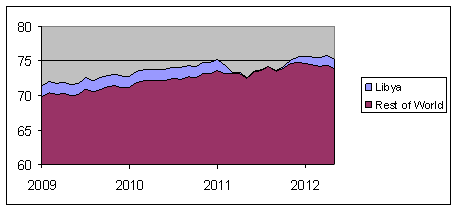Some people observed 9/11 by lighting candles, others by killing more Americans.
Last week a mob stormed the U.S. Consulate in Benghazi, Libya, killing the U.S. ambassador to Libya and three other Americans. Among other implications, this raises the possibility that the stability that seemed to have returned to that country may be short-lived.
As of May, the EIA estimates that the world was producing 75.3 million barrels a day of crude oil (not including natural gas liquids, biofuels, or refinery processing gain). That’s up a million barrels a day from where it had been last October. However, all of the gains since October came from the return of Libyan production after the unrest seen there last year.

Crude oil production from Libya and rest of the world, millions of barrels per day, Jan 2009 to May 2012. Excludes natural gas liquids, other liquids, and refinery processing gain. Data source: EIA. Note vertical axis does not begin at zero.
A crowd of 2,000 had also gathered at the U.S. embassy in Cairo, Egypt, though no one was killed there. The U.S. embassy in Algeria issued warnings to Americans there. Last week, Canada closed its embassy in Tehran, Iran.
In other news, while some have speculated that Venezuela’s leader Huge Chavez may be terminally ill, on Monday he warned of a possible civil war if his policies are opposed. In Nigeria, Islamist groups are conducting open warfare on churches and police stations. In Iraq, 75 people were killed and 300 wounded in a wave of attacks on Sunday, and the fugitive vice president was sentenced to death by hanging.
Below I provide data on the importance of the countries just mentioned for world oil production. The table leaves out Egypt, which by itself only produces a little over a half million barrels a day, though another 2 mb/d travel through the Suez Canal and SUMED pipeline.

Oil production in May 2012 (in millions of barrels per day and as a percent of world total). Data source: EIA.
The table also includes Saudi Arabia, for which I did not highlight a specific recent news development. But note that even if all remains calm in the kingdom, most Saudi oil is currently getting to market as part of the 17 mb/d going through the Strait of Hormuz.

Oval highlights Strait of Hormuz. Source: EIA.
- Bulenox: Get 45% to 91% OFF ... Use Discount Code: UNO
- Risk Our Money Not Yours | Get 50% to 90% OFF ... Use Discount Code: MMBVBKSM
Disclaimer: This page contains affiliate links. If you choose to make a purchase after clicking a link, we may receive a commission at no additional cost to you. Thank you for your support!



Leave a Reply